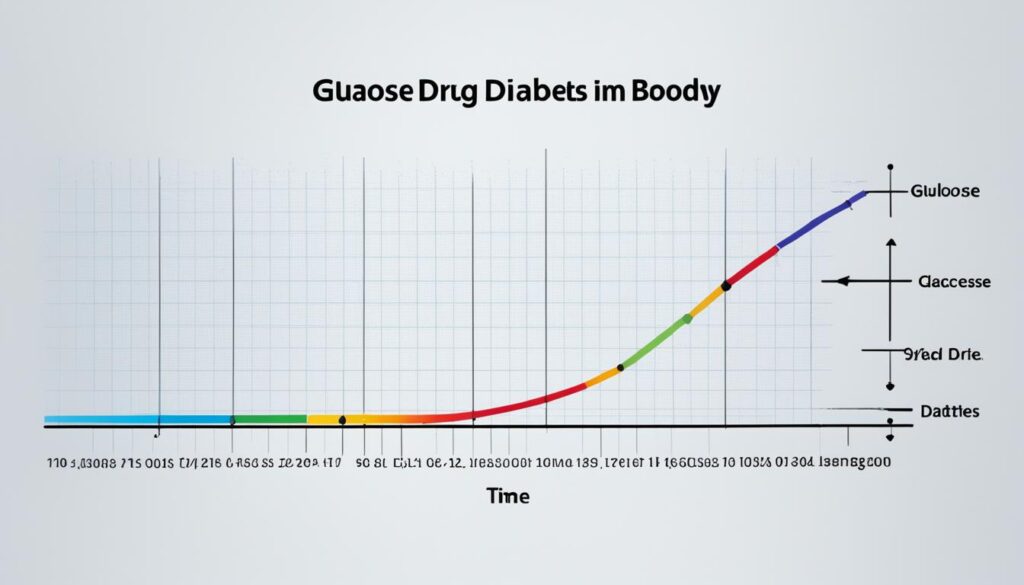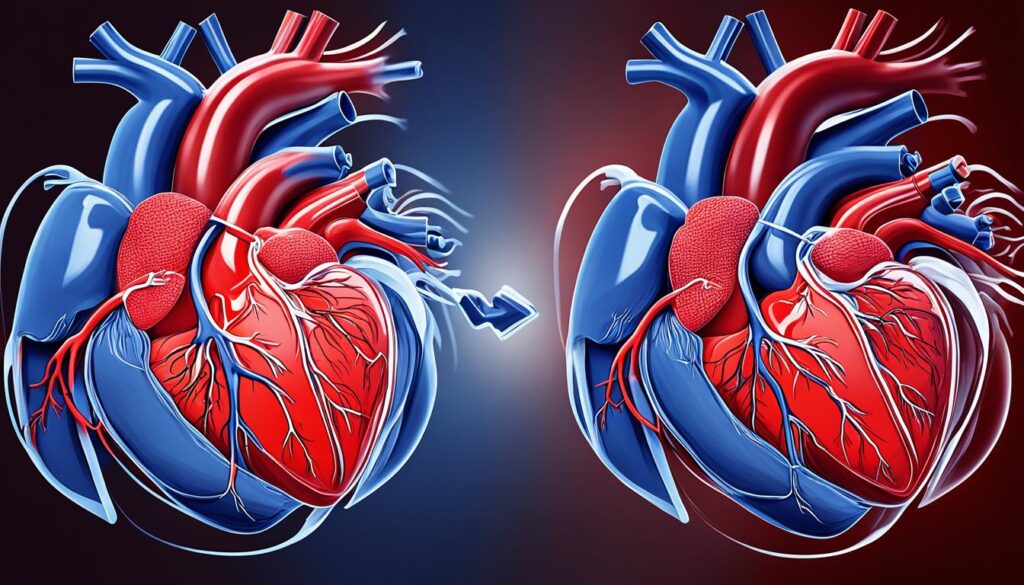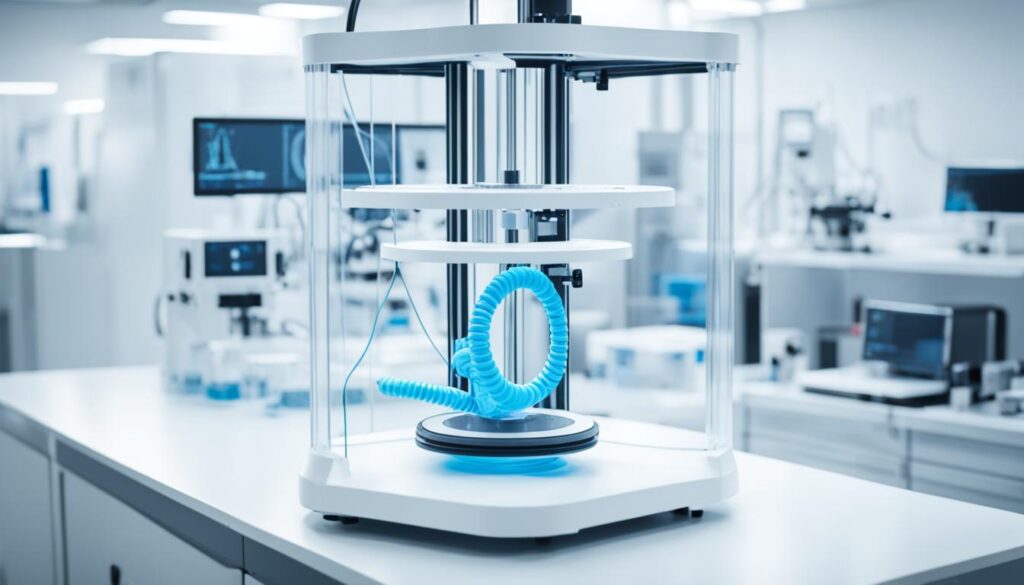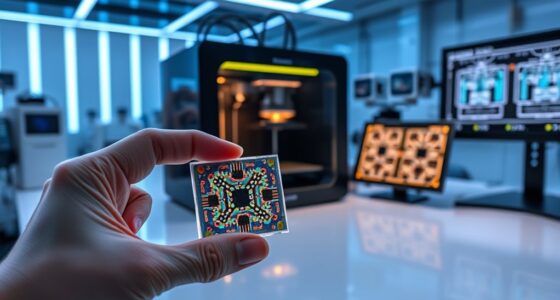Imagine a world where healthcare is changed by new discoveries, making patient care better and changing medical research. This is what we’re moving towards with the top 10 health innovations from the Cleveland Clinic for 2022. These innovations could change the future of medicine and improve healthcare in many areas.
Meet Simon, a 45-year-old father of two who got diagnosed with prostate cancer. His story shows how these innovations are making healthcare better and improving patient outcomes.
Simon’s story starts with next-generation sequencing, a technology that finds genetic changes in his cancer cells. This helps his doctors create treatments just for him. Thanks to precision medicine, Simon gets treatments that match his unique genetic makeup1.
During his treatment, Simon uses 3D-printed medical devices. These devices help him move better and improve his life quality. Because 3D printing is affordable, these devices can be made for patients at a lower cost1.
Simon also gets help from immunotherapy, which makes his treatment less tough. This method uses Simon’s immune system to fight cancer cells. It gives hope to patients like Simon1.
Artificial intelligence helps Simon’s doctors make better decisions. AI can look at lots of data fast and accurately. This means Simon gets the best care possible1.
Simon also uses point-of-care diagnostics, which makes testing easy and quick. This helps his healthcare team keep track of his progress and adjust his treatment as needed1.
For pain management and getting back on his feet, Simon uses virtual reality. VR helps him recover faster and stay motivated with fun experiences1.
Social media is used by Simon’s healthcare team to keep up with health trends and patient feedback. This helps them improve care and adapt to new health needs1.
Biosensors and trackers in Simon’s clothes and devices help monitor his health easily. These wearable technologies give real-time health updates, helping Simon and his doctors keep track of his progress1.
Retail clinics and urgent care centers are also part of Simon’s care. They offer affordable and easy-to-get healthcare services. This means Simon can get the care he needs without the long waits and high costs of hospitals1.
Telehealth is also important for Simon, giving him easy access to self-care. It cuts down on office visits and travel, saving Simon time and preventing more serious health issues1.
Simon’s story shows how these top 10 health innovations are changing medicine today. From personalized treatments and advanced tests to easy care and AI, these innovations are making healthcare better and improving patient outcomes. The future of medicine looks very promising.
Key Takeaways:
- Next-generation sequencing enables personalized treatments based on genetic profiles1.
- 3D-printed medical devices offer customized and affordable solutions1.
- Immunotherapy extends survival without the side effects of traditional chemotherapy1.
- Artificial intelligence enhances diagnostics and treatment decision-making1.
- Point-of-care diagnostics provide convenient and timely testing1.
Next Generation of mRNA Vaccinology
The mRNA vaccine field has seen huge leaps forward. This has led to new vaccines for diseases like cancer and Zika virus. These advances could change how we treat and prevent healthcare diseases.
Over2 670 million mRNA vaccine doses have been given to people in the US. This shows how effective and popular this technology is2. For years, mRNA-based treatments and vaccines were being worked on. But recent breakthroughs have made them much better at making proteins, improving how they work with the immune system, and getting them into the body3. These changes have opened up new ways to fight infectious diseases and cancer with mRNA.
Companies like Moderna and BioNTech, working with Pfizer, are leading the charge in making mRNA vaccines for many diseases. Moderna is working on vaccines for RSV, HIV, Zika, Epstein-Barr virus, and more2. BioNTech and Pfizer are looking into mRNA vaccines for tuberculosis, malaria, HIV, shingles, and flu2. These efforts show how versatile mRNA technology is and its ability to tackle global health issues.
Also, mRNA vaccines are showing great promise in tests. Moderna found one vaccine can protect against 20 different flu types in trials2. Scientists are also exploring mRNA vaccines against a wide range of coronaviruses2. These findings show how mRNA technology can quickly adapt to new diseases.
Another big plus is how fast mRNA vaccines can be made compared to old methods2. This speed makes mRNA vaccines key in fighting infectious diseases. It helps us respond faster to outbreaks and pandemics.
But mRNA vaccines aren’t just for infectious diseases. They’re also being tested for cancer, like dendritic cell vaccines and directly injected mRNA. These early results offer hope for better cancer treatments3. This shows mRNA technology could change cancer treatment too.
In summary, the next wave of mRNA vaccinology is very promising for healthcare. With ongoing research, tech improvements, and company efforts, we can expect more mRNA vaccines for diseases and cancer soon. mRNA vaccines are not only effective but also cost-effective to make. They’re a game-changer in fighting health challenges.
PSMA-Targeted Therapy in Prostate Cancer
Prostate cancer is the most common cancer in men, with over 1.4 million new cases in 20204. It’s the second leading cause of death from cancer in men in the U.S4..
PSMA-targeted therapy is a big step forward in treating prostate cancer5. It uses PET scans and tracers to find cancer early, much better than old methods6. This leads to treatments like radiation and surgery that are more precise, helping to save healthy tissue and improve results6.
Every year, over 200,000 American men get prostate cancer diagnosed, making it the most common cancer in U.S. men5. Experts think PSMA-targeted therapy will soon be the go-to method for finding cancer early, which could lead to better treatment outcomes5.
Advantages of PSMA-Targeted Therapy
PSMA-targeted therapy has many benefits for prostate cancer treatment. It allows for targeted treatments like radiation, surgery, and more, based on each patient’s needs6. Plus, it got FDA approval in 2020, showing its potential as a major medical breakthrough6.
PSMA-targeted therapy could also help with other cancers because many have PSMA on their blood vessels4. Researchers are working on making it even better, trying new combinations and ways to use it4.
| Statistics | Reference |
|---|---|
| PSMA-targeted therapy is highlighted as a significant innovation in the Top 10 Medical Innovations for 2022 | 5 |
| Over 200,000 American men receive a diagnosis of prostate cancer each year | 6 |
| PSMA PET scans showed substantially increased accuracy for detecting prostate cancer metastasis compared to conventional imaging methods | 6 |
| PSMA-targeted therapy allows for a targeted approach with stereotactic body radiation therapy, surgery, and systemic therapy | 6 |
| PSMA-targeted therapy received FDA approval in 2020 | 6 |
| Prostate cancer is the most common non-skin cancer in men | 4 |
| Approximately 1.4 million new cases of prostate cancer were diagnosed worldwide in 2020 | 4 |
| Prostate cancer is the second leading cause of cancer-related mortality in men in the United States | 4 |
| Ongoing clinical trials aim to optimize efficacy and safety of PSMA-targeting agents and explore novel combinations and dosing strategies | 4 |
The EJNMMI/SNMMI guidelines on PSMA PET and therapy give detailed advice on using PSMA in treating prostate cancer4.
New Treatment for the Reduction of LDL
Recent medical breakthroughs have led to new ways to fight heart disease. One key treatment is inclisiran, an RNA therapy given as an injection, used with statins.
Studies show that inclisiran with statins lowers LDL cholesterol well. This treatment aims to cut the risk of heart disease and its problems.
Inclisiran is part of a new type of medicine that targets several health issues at once. This could lead to better treatment options and outcomes for patients. Adding inclisiran to statin therapy could make managing heart disease more effective and help patients stick to their treatment plans7.
New tech has also brought better ways to diagnose and treat heart conditions. For example, e-tattoos can track patients’ health over time, helping doctors make better decisions7.
There are also new devices that can ease chronic pain by sending signals to the spinal cord. This could mean less need for painkillers, which can have bad side effects7.
Robots and prosthetics are getting better too. Next-gen exoskeletons help elderly people move again, preventing injuries. These robots are changing rehab for people with heart conditions7.
AI-powered apps are now helping people stay healthy. These apps use games and personalized advice to encourage healthy habits. This can lead to better heart health7.
Online platforms are changing how we manage chronic diseases like heart disease. They make it easier for doctors and patients to share information and talk in real time. This is especially helpful for people with diabetes7.
Benefits of New Treatment Options for Heart Disease
New treatments like inclisiran are making a big difference in heart disease care. They can work well with current treatments to lower LDL cholesterol levels. This means better health outcomes for people with heart disease. Thanks to new tech and medicines, doctors can now manage heart disease more effectively, improving patients’ lives.

| Treatment | Key Benefits |
|---|---|
| Combination of inclisiran and statin therapy | – Effective and sustained reduction in LDL cholesterol levels – Improved heart disease management – Potential reduction in medication non-compliance – Enhanced patient outcomes |
| Connected and cognitive devices | – Longer monitoring periods – Enhanced clinical decision-making |
| Implantable microchips for pain management | – Reduction in the need for pain medication – Mitigation of chronic pain |
| Next-generation exoskeletons | – Restoration of movement and autonomy in elderly patients – Prevention of accidental injuries |
| Digital therapeutics | – Adoption and sustainment of healthy behaviors through gamification |
| Multichannel care delivery | – Facilitated data sharing – Improved treatment efficiency for chronic diseases |
New treatments like inclisiran bring hope to those with heart disease. They help lower LDL cholesterol and use the latest medical tech. As these treatments grow, people with heart disease can look forward to a better life with less disease.
Novel Drug for Treatment of Type 2 Diabetes
A new drug for type 2 diabetes has been discovered8. It’s a once-a-week shot that uses two key substances to help manage blood sugar and aid in weight loss. This could change the way we treat diabetes and obesity together.
About 90-95% of diabetes cases are type 29. It’s a big challenge for people and healthcare around the world. Obesity, sitting too much, and eating poorly are big reasons why it happens9. So, finding good treatments is crucial.
This new treatment helps control blood sugar and can help you lose weight. It’s a big deal for people dealing with both diabetes and obesity. Studies show it can really help lower blood sugar levels9. Plus, it helps with weight loss, which is great news for those struggling with both issues.
There’s been a rise in type 2 diabetes in young people lately9. This is a big worry. We need treatments that work well for all ages and types of people.
Genes play a part in getting type 2 diabetes, but so does lifestyle9. We need to tackle it from all angles. This means using medicine, eating right, and moving more.
By 2045, the number of adults with diabetes could jump to 700 million if we don’t act9. This new drug offers hope for millions facing this condition.
Advancements in Diabetes Research and Treatment
Diabetes research has made big strides. Studies in top journals have uncovered new ways to manage diabetes10.
A study in BMJ in 2016 showed that certain medicines can help manage diabetes10.
Research in 2013 found a natural substance that could help protect against diabetes complications in rats10.
A review in JAMA in 2015 looked at how certain medicines can lower blood pressure in people with diabetes10.
A 2014 review talked about herbs that might help treat diabetes10.
A 2019 study explored how oxidative stress affects diabetes and its complications10.
These studies offer new insights into diabetes and suggest ways to treat it better.

This new drug is a big step forward in managing type 2 diabetes8. It combines two substances to help control blood sugar and aid in weight loss. This could be a game-changer for people with diabetes.
The world of diabetes treatment is always evolving. This new drug shows how far we’ve come. With ongoing research and a focus on better blood sugar control and weight loss, the future looks bright for diabetes patients.
Breakthrough Treatment for Postpartum Depression
An intravenous infusion treatment using a neurosteroid has shown promise in rapidly treating postpartum depression. This new treatment targets the hormone imbalance that causes depression. It could offer rapid relief for women struggling with postpartum depression.
About 1 in 7 new mothers suffer from postpartum depression. Current treatments like antidepressants and therapy can take weeks to work. But, this new intravenous therapy with a neurosteroid could be a quick solution for hormone-sensitive postpartum depression.
Research shows that a brain steroid called allopregnanolone changes a lot during and after pregnancy. It’s key for mental health, and not having enough of it is linked to postpartum depression. This therapy aims to fix this imbalance with an intravenous infusion, helping to ease depression.
In 2019, a new drug called brexanolone was approved for postpartum depression. This was a big step forward in treating depression. Studies show it can quickly help women feel better.
Studies back up the effectiveness of this neurosteroid treatment. Women taking a 50-milligram dose of zuranolone showed big improvements in depression. This is based on FDA-approved trials1112.
A study with 196 women found that zuranolone helped a lot more than a placebo. After two weeks, 57% of women taking zuranolone felt much better. This shows it works fast, with some women seeing improvement by day three11.
Zuranolone also helped women feel better over time. Women taking it kept getting better for 45 days. This shows it could be a long-term solution for postpartum depression11.
Zuranolone is being closely watched by the FDA for approval. It could be a major breakthrough for treating postpartum depression. The FDA’s decision is expected soon, with hopes it will be widely used11.
But, it’s important to consider the side effects of zuranolone. Women taking it might feel sleepy, dizzy, or very relaxed. Some even lowered their dose because of these effects. So, it’s key to weigh the risks and benefits before starting treatment11.

References:
- Breastfeeding and Postpartum Depression. (n.d.). CDC. Retrieved from https://www.cdc.gov/breastfeeding/breastfeeding-special-circumstances/maternal-or-infant-illnesses/postpartum-depression.htm.
- Zuranolone Associated With Rapid Improvements in Depressive Symptoms. (2021, May 20). Healio. Retrieved from https://www.healio.com/news/psychiatry/20210520/zuranolone-associated-with-rapid-improvements-in-depressive-symptoms#:%7E:text=Results showed most patients achieved on the condition they pass a review, but it is not set in stone.
- Treatment of Postpartum Depression. (2021, June 11). Stanford Medicine. Retrieved from https://med.stanford.edu/psychiatry/special-initiatives/mentalhealth/ppd.html.
Targeted Medication for Hypertrophic Cardiomyopathy
A new medicine is being made just for hypertrophic cardiomyopathy (HCM). It’s showing good results in easing symptoms and making life better for patients13. HCM makes the heart muscle thick, often from genetic changes. This can cause shortness of breath, chest pain, feeling tired, and racing heart.
How HCM affects people can vary a lot. Some might not feel any symptoms or have mild ones. Others might have severe symptoms and the disease gets worse fast. It’s key to manage symptoms and slow the disease to help patients13.
Right now, treating HCM focuses on easing symptoms and preventing serious problems. But, there hasn’t been a medicine just for HCM. So, finding a new medicine made just for HCM is a big deal in cardiology and gives hope to patients14.
This new medicine for HCM aims to fix the genetic issues that affect the heart. By targeting these genetic problems, it could change how the disease works and help treat it better14.
New Hope for HCM Patients
This new medicine could make life easier for HCM patients by easing symptoms and slowing the disease down1413. It targets the genetic causes of HCM, which could lessen heart muscle thickening, reduce symptoms, and lower the risk of serious issues like arrhythmias and heart failure.
Also, this medicine could make HCM patients’ lives better overall. It could help them do more, feel less tired, and enjoy daily activities13. This could be a big change in treating HCM, offering hope and new possibilities to patients.

Advancements in HCM Treatment
This new HCM medicine is still waiting for approval but it’s very promising14. Making this medicine is a big step forward, moving from just treating symptoms to tackling the disease’s root cause.
There are also other new ideas in HCM treatment being looked at. These include using advanced analytics to spot early signs of the disease, exploring non-drug treatments, and testing new therapies in clinical trials1413.
Thanks to ongoing research, the future of treating hypertrophic cardiomyopathy looks bright. With new medicines and methods, people with this condition could see better symptom control, slower disease progression, and better health outcomes1413.
Non-Hormonal Alternatives for Menopause
{Non-Hormonal Alternatives for Menopause image: menopausal woman cooling down}
If you’re going through menopause, you might know how hot flashes can disrupt your life. These sudden heat waves can make it hard to sleep and affect your daily activities. While hormone therapy is often used to help, there are other ways to manage these symptoms without hormones.
Statistical data from15 shows that up to 80% of women going through menopause get hot flashes and night sweats. These symptoms can last for 7 to 9 years, and for some, even longer. After the Women’s Health Initiative, fewer women started hormone therapy, especially younger ones and those with worse symptoms16.
Table: Non-Hormonal Treatment Options for Menopausal Symptoms
| Treatment | Potential Benefits | Research and Evidence |
|---|---|---|
| Lifestyle Changes | May reduce frequency of vasomotor symptoms | – Suggested cooling techniques and avoiding triggers16
– Observational studies indicate regular exercise may help reduce symptoms, but some evidence suggests it could trigger symptoms16 |
| Supplements and Herbal Remedies | May relieve certain menopausal symptoms | – Clinical trials evaluating efficacy are ongoing |
| NK3R Antagonists | Promising non-hormonal option to relieve hot flashes | – Non-hormonal drugs known as NK3R antagonists have shown effectiveness similar to hormone therapy in reducing hot flashes15 |
| Psychological Therapies | May help manage emotional and psychological symptoms | – Cognitive behavioral therapy (CBT) has shown some positive results |
Lifestyle changes, like cooling down and avoiding certain triggers, might help with hot flashes. But we need more research to be sure16. Studies suggest exercise can also help, but it might make symptoms worse for some women16.
Another option is using NK3R antagonists, which target a brain pathway linked to hot flashes. Statistical data from15 shows these drugs work as well as hormone therapy in easing hot flashes. This gives women another choice for managing this symptom15.
Companies like Evernow and Midi Health are offering support and resources for women in perimenopause and menopause. They provide information and access to treatments and therapies for menopause15.
Women going through menopause are at higher risk for many health issues, including heart disease and osteoporosis. Finding safe and effective treatments that don’t involve hormone therapy is key to improving their health during this time15.
Implantable for Severe Paralysis
Severe paralysis can greatly affect people, making everyday tasks hard and lowering their life quality. But, new tech like implantable brain-computer interfaces (BCIs) gives hope. These devices can help paralyzed people regain control over their movements.
BCIs work by reading brain signals and turning them into commands for devices. This lets paralyzed people control digital tools with their minds. It’s a big step towards independence.
These devices use electrodes to connect the brain to devices outside the body. For those with severe paralysis, this tech is a game-changer. It brings new chances for daily life and freedom.
Thanks to brain-computer interfaces, people with paralysis can control devices and interact with the world in new ways. They can use computers, operate assistive tools, or even move a wheelchair with their thoughts. This tech is a peek into the future of helping paralyzed people.
BCIs could change the lives of millions with paralysis. They can bring back motor skills and enhance life quality. This breakthrough shows how far medical tech has come and hints at future advances.
As research and development continue, we’ll see more improvements in BCIs. This means better lives for those with severe paralysis. Connecting digital devices with the brain opens up new chances for mobility and independence.
In summary, implantable brain-computer interfaces are a major step towards helping paralyzed patients. With more progress, this tech could change healthcare and greatly improve life for those with paralysis.

AI for Early Detection of Sepsis
AI is changing healthcare by spotting serious conditions like sepsis early. It uses real-time monitoring and quick action. By looking at patient records, AI can find those at high risk of sepsis fast. This lets doctors act quickly and help patients better.
Mayo Clinic is using AI to find early signs of heart failure17. AI also helps doctors check CT scans and X-rays better. This leads to catching diseases like breast cancer, pancreatic cancer, and osteoporosis early17.
AI has been a big win in treating sepsis. At Cleveland Clinic, AI helped improve treatment by 40%17. AI can spot sepsis about six hours before old methods, as seen at Johns Hopkins Medicine18.
During COVID-19, UCLA Health System saw a huge jump in telemedicine visits17. Telemedicine lets doctors use AI to check symptoms and give full check-ups. For example, Hospital Sírio-Libanês in Brazil fixed 90% of cases with AI help in the first visit17.
Adding AI to healthcare also saves money. The U.S. could save about US$360 billion with AI in healthcare19. AI can also make making new drugs cheaper and faster19. In 2022, the FDA approved 91 medical devices with AI in the U.S19..
AI can create digital markers from health data, helping with diseases that mostly affect women. The FDA is now guiding how to use AI for things like predicting sepsis and heart failure19.

Next-Generation Sequencing for Genetic Analysis
Next-generation sequencing has changed how we study genes, giving us deep insights into genomics. This technology has helped researchers understand the genetic roots of many diseases. This knowledge leads to better treatments and personalized medicine20.
Genomic medicine is key to precision medicine, as recent studies show. For example, a 2022 study by Hasanzad M showed how analyzing genes can lead to tailored treatments. This could change healthcare and greatly improve patient care20.
Next-generation sequencing is especially useful for treating genetic disorders. Conditions like beta-thalassemia and sickle cell disease are challenging. But, with gene therapy, like Ivacaftor for cystic fibrosis, new treatments are emerging. These offer hope and better lives for patients20.
Let’s look at how DNA sequencing has evolved. A 2017 review by Mardis ER highlighted major advances from 2006 to 2016. This progress has made it possible to analyze genes more efficiently, speeding up our understanding of complex diseases20.
PacBio sequencing is a breakthrough in DNA sequencing. In 2015, Rhoads A and Au KF explained its benefits, like giving long, accurate reads. This helps us understand genetic variations better. SMRT sequencing, discussed in 2013, also offers high accuracy in genetic analysis20.
Nanopore sequencing is another big step forward. Articles from 2017 and 2018 talk about its potential to change how we see genetic variations. It can analyze genes in real-time, offering deep insights into genomics20.
Improving genetic tests for diseases is crucial. Infections like the flu and Legionnaires’ disease are big health concerns. Fast and accurate genetic tests are key to spotting and treating these diseases early20.
Watching for new virus strains is also vital. The COVID-19 pandemic showed us how important this is. Studies in 2022 pointed out the role of genetic analysis in tracking and stopping new virus strains. This helps save lives20.

| Advancement | Publication | Year |
|---|---|---|
| Genomic Medicine | Horton RH and Lucassen AM | 2019 |
| Precision Medicine | Hasanzad M | 2022 |
| Gene Therapy | Leonard A et al. | 2022 |
| Novel Therapeutic Approaches | Roberts RJ et al. | 2013 |
| DNA Sequencing Evolution | Mardis ER | 2017 |
| High-Throughput Sequencing | Reuter JA et al. | 2015 |
| PacBio Sequencing | Rhoads A and Au KF | 2015 |
| SMRT Sequencing | Roberts RJ et al. | 2013 |
| Nanopore Sequencing | Various articles | 2017-2018 |
| Infectious Disease Testing | Various articles | Multiple years |
| Surveillance of Emerging Variants | Various articles | Multiple years |
3D-Printed Medical Devices
3D printing has changed healthcare for the better. It lets us make medical devices that fit each patient perfectly. This technology is making healthcare more personalized and affordable.
Recently, more hospitals have started using 3D printing for making medical items right at the hospital. In 2019, 113 hospitals had these machines, up from just three in 201021. This shows how much 3D printing is helping healthcare.
The FDA has approved many medical products made with 3D printing21. Things like hearing aids and prosthetics are being made in new ways. This technology lets us make devices that fit each patient’s body perfectly.
During the COVID-19 pandemic, 3D printing was a big help. Hospitals used it to make masks and other important items fast21. This was cheaper than traditional ways and helped a lot.
Studies show how powerful 3D printing is in healthcare. It’s changed how we fix bones and cartilage, making treatments better21. It also helps surgeons plan surgeries better, saving time and money.
3D printing has also made prosthetic hands and arms possible. A group called e-NABLE uses 3D printing to make over 8,000 prosthetics for people21. This has changed lives.
Another big area is making organs and tissues. 3D printing can create things that look just like real tissues and organs. This could lead to new ways to treat diseases22. Researchers are working on making 3D-printed organs like livers and kidneys.
Studies and Findings
Studies support the benefits of 3D printing in healthcare. They show it saves money, improves care, and does more things.
- A study in the Journal of the American Academy of Orthopaedic Surgeons found big benefits for fixing bones and cartilage with 3D printing21.
- Researchers made a robotic spine model with 3D printing. It helps surgeons plan surgeries with 100% accuracy21.
- A study in Academic Radiology found surgeries took less time with 3D models. This saved time and money21.
3D printing is changing healthcare for the better. It makes devices that fit each patient, helps with surgeries, and could change how we treat diseases. As it gets better, we’ll see even more changes in healthcare.
Examples of 3D-Printed Medical Devices
| Medical Device | Application |
|---|---|
| Prosthetic Limbs | Customized prosthetics tailored to individual anatomy, offering improved comfort and functionality21 |
| Hearing Aids | Rapid production and customization of hearing aids, reducing the production time from over a week to just one day21 |
| Surgical Tools and Guides | Creation of precise and patient-specific surgical tools and models, improving surgical planning and reducing errors21 |

Using 3D printing in healthcare is very promising. It offers personalized care, saves money, and improves outcomes. As the technology gets better, we’ll see more innovation in medical devices.
Conclusion
The healthcare industry is seeing big changes with new tech in fields like glycobiology and artificial organs23. These new ideas could change medicine and help patients a lot.
Working together, companies and schools are key to making healthcare better23. They share their skills and resources to speed up new discoveries. But, they face challenges like who owns the ideas and making sure they’re safe and follow the rules23.
New tech like telemedicine and wearable health devices are changing how we get healthcare24. Telemedicine lets people get medical help from anywhere, and wearable devices help patients keep track of their health24. AI helps find diseases faster and more accurately, leading to better treatments for each patient24. Robots in surgery mean less invasive procedures and better care for patients24.
But, we must think about the right way to use these new technologies24. We need to protect patient privacy and make sure AI is fair. Making sure everyone can use medical tech is also key. This means making it affordable and designing it for all kinds of patients24.
The future of healthcare looks exciting, with big growth in areas like telehealth and 3D printing25. These advances could change healthcare, make patients better off, and shake up the medical world.










